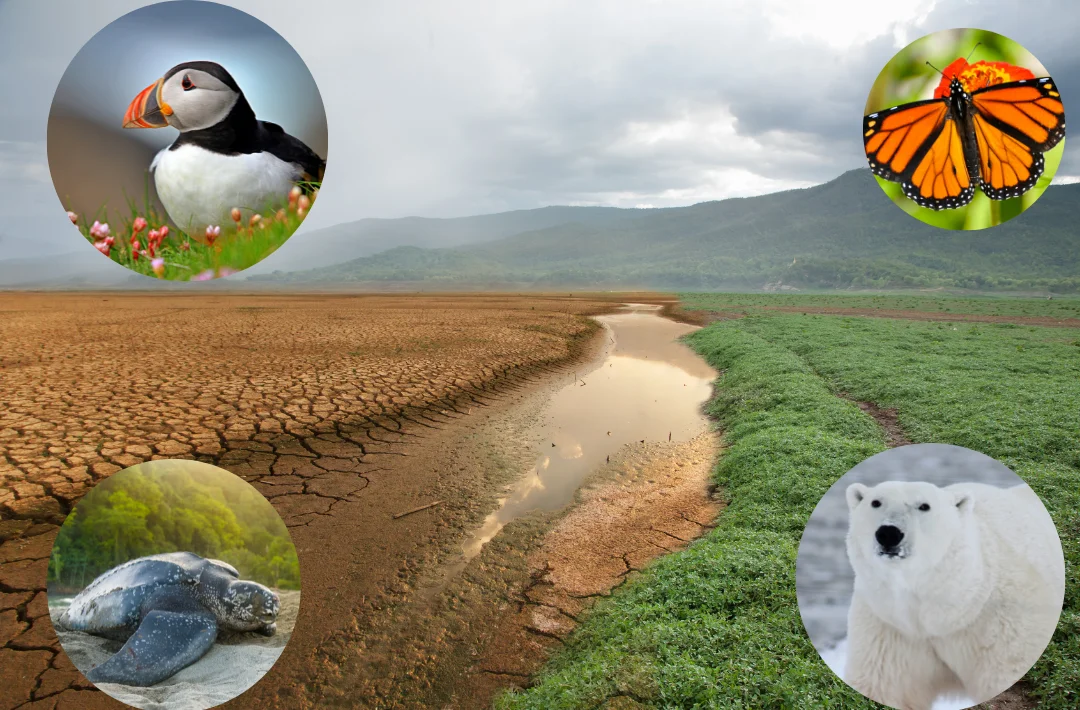
Article by
Climate variation is probably the most debated issue confronting all over the world. Wildlife represents one of the many groups of living beings that are most vulnerable from these globally climatic changes. The International Panel on Climate Change (IPCC) predicts that the global temperature keeps on getting warmer at the present rate, 20 to 30% of plant and animal species will become extinct at the end of the 21st century. According to the International Union for Conservation of Nature (IUCN), assessed 44,000 of the species are threatened with extinction. Environmental changes caused a global heat wave and fires in the forest, half of the globe's original forests have vanished and the remaining ones are being cut down at a tenfold faster rate effects on their species habitats.
The purpose of this article is to draw attention to just how climatic changes are affecting across the globe. Looking forward, much can be realized by examining faunal responses to previous instances of environmental change such as persistent shifts in temperature, weather trend, and urbanization which result in habitat loss. Changes in ranges of species majorly contribute to their extinction.
Species range shifts is a complicated but highly organized process triggered by a variety of environmental cues, including temperature, day length, and food availability. However, as climate change alters these signals, many species have trouble adjusting to the new environment. These forecasts indicate that species will shift their ranges to higher latitudes, deeper depths and higher elevations for the purpose of their temperature niche. Warm temperatures cause species to migrate earlier in the year, disrupting their paths and interactions with one another. For example, small mammals’ species in Polar Regions migrate due to sea ice losses and glacial breakdown are the clearest signals for their migration to their suitable areas.
Urbanization causes fragmentation of habitat, in which larger continuous habitats are separated into smaller, disconnected patches. Habitat loss for various species, including small mammals, are caused by environmental changes. Many animal species depend on particular habitats for availability of food, shelter, and reproduction, the changes in these environments may interrupt these essential seasonal activities. It may decrease genetic variation and increase the chance of depression caused by inbreeding. The depletion of habitat has also an impact on ecosystems that provide vital functions such as the pollination and cycling of nutrients.
The extinction of species populations by climate change represents broad effects with a wide range of taxa, especially small mammal’s species. The keystone species in small mammals like rats, mice, squirrels and voles perform a major part as primary food source for a diverse range of predators in sustaining the fundamental framework of an ecological community. When these keystone species removed from an ecosystem by climatic changes have major consequences to affect the trophic cascade which result in extinction of itself and other predators’ species. For example, The Bramble Cay melomys (Melomys rubicola) , known as Bramble Cay mosaic-tailed rat, is a first rodent noted to have gone extinct as the direct result of climate change.
Long Term Initiatives for Wildlife Survival
• Protecting habitats is a key solution to protect wildlife, such as by creating protected areas and encouraging environmentally friendly land use practices. This may assist make sure that species have access to the resources and habitats that they need for their development and long-term survival.
• Besides, it is also essential to recover deteriorated habitats, especially transplanting forests or replenishing wetlands because it may assist with enhance the capacity of ecosystems and species to respond to fluctuating conditions.
• Decreasing the emissions of greenhouse gasses is among the most effective ways to help the effects of climate change on wildlife. It can be accomplished via a variety of strategies, including switching to renewable energy sources and encouraging environmentally friendly mode of transportation options.
• Establishing backyard habitats and including building habitat characteristics into current structures are great ways to enhance natural habitats in urban areas. Furthermore, establishing functional habitats and allowing for their use through design elements such as wildlife corridors and safe road crossings may help fulfill the demands of fish and wildlife in the built environment.
• Encouraging the adaptation strategies that can assist species in dealing with changing conditions include measures such as recovering connectivity among fragmented habitats of species, and carrying out conservation breeding initiatives for species at risk.
The urgency of addressing climate change cannot be overstated, especially considering its profound impact on wildlife populations worldwide. However, by implementing proactive conservation measures and prioritizing habitat protection, we can mitigate the threats posed by climate variation and safeguard the future of our planet's diverse species.
Together, let's take decisive action to preserve the rich biodiversity of our world for generations to come.
 Monthly "Azeem English Magazine", launched in 2000, records the information about diverse fields like mental health, literature, research, science, and art. The magazine's objective is to impart social, cultural, and literary values to society.
Monthly "Azeem English Magazine", launched in 2000, records the information about diverse fields like mental health, literature, research, science, and art. The magazine's objective is to impart social, cultural, and literary values to society.
+92 51 88 93 092
First Floor, RAS Arcade, Eidhi Market, Street#124, G-13/4, Islamabad, Pakistan, 44000.